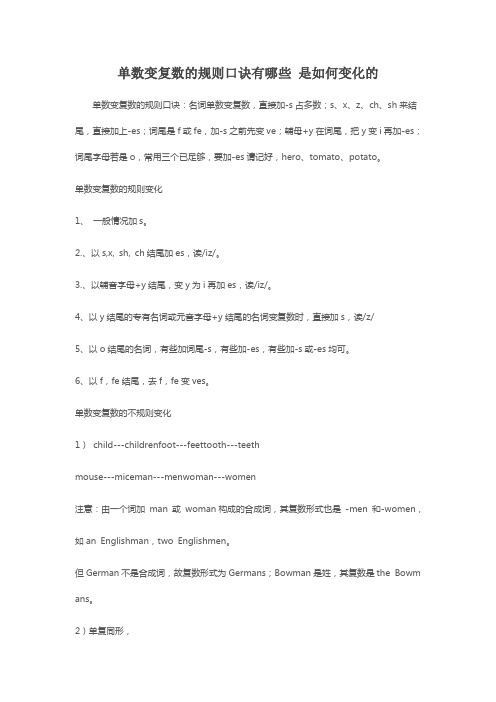复数变化规则
英语复数变化规则

英语复数变化规则1.一般情况下,直接加S(apple-apples,pig-pigs,book-books等)2.以s、sh、ch、x结尾的名词,加es,如:bus-buses(公车),class-classes(班级),fish-fishes(此时的fish当“鱼的种类”讲),watch-watches(手表),box-boxes(盒子),fox-foxes(狐狸)3.以元音字母+y结尾的名词,直接加s,如:boy-boys(男孩),toy-toys(玩具)4.以辅音字母+y结尾的名词,去y改ies,如:family-families(家庭),strawberry-strawberries(草莓)5.以f或fe结尾的名词,去f或fe改ves,如:wife-wives,knife-knives,wolf-wolves (这三个词的记忆口诀---“妻子”拿着“小刀”杀了“狼”)6.以”o"结尾的名词:(1)有生命的,加es,如:potato-potatoes,tomato-tomatoes,hero-heroes (这三个词的记忆口诀---”英雄“爱吃”土豆“和”西红柿“)(2)无生命的,加s,如:photo-photos(照片),radio-radios(收音机)7.将“oo”改为“ee"的名词,如:tooth-teeth(牙),foot-feet(脚),goose-geese(鹅)8.单复同形的名词:(1)fish-fish,sheep-sheep,paper-paper,Chinese-Chinese,Japanese-Japanese(日本人),people-people(peoples表示“民族”)(2)不可数名词,如:water(水),rice(米饭),milk(牛奶),juice(果汁),bread(面包),tea(茶),orange(橙汁)9.不规则变化的名词:(1)man-men,woman-women (记忆方法---“男人”“女人”将a改e) 延伸:policeman-policemen,policewoman-policemen(2)child-children(孩子)(3)mouse-mice(老鼠)(4)根据中文意思变化的名词,如:I-we(我-我们),you-you(你-你们),he/she/it-they(他/她/它-他们),this-these(这个-这些),that-those(那个-那些)练习写出下列名词的复数形式:I this that watch child photo diary(日记) day Foot wolf peach sandwich man woman paper water juice tea mouse book dress(连衣裙) tooth sheep box strawbary bread tomato potatoThere are 56 (people)in China.。
单数变复数规则

单数变复数规则英语可数名词由单数变复数,有八种方法:1.最普遍的是直接加s。
如:book-books, cake-cakes, house-houses。
2.一般而言,以ch、sh、ss、x等结尾的名词,变为复数需加es。
如:class-classes,match-matches,box-boxes,brush-brushes。
3.以o结尾时,有生命的名词加es,无生命的加s。
如:tomato-tomatoes,potato-potatoes, photo-photos。
4.改y为ie。
如:baby-babies,city-cities,country-countries。
5.以f或fe 结尾的名词变复数时:6. a. 加s,如:belief-beliefs, roof-roofs, safe-safes, gulf-gulfs,handkerchief-handkerchiefs;7. b. 去f, fe加ves,如:half-halves, knife-knives, leaf-leaves, wolf-wolves,wife-wives, life-lives, thief-thieves。
8.词中有oo的,改oo为ee。
如:foot-feet,tooth-teeth,goose-geese。
9.单复同形。
如:clothes-clothes, deer-deer, fish-fish, glasses-glasses, sheep-sheep 及集体名词:Chinese-Chinese, people-people。
但是,若是表示多条鱼,fish的复数还是fish;若是表示多种鱼,种类有多种,那么fish的复数就应为fishes。
10.不规则变化。
如:child-children, man-men, woman-women, louse-lice, mouse-mice, ox-oxen。
可数名词单数变复数变化规则

可数名词单数变复数变化规则
在英语中,可数名词单数变为复数时,常常根据以下规则变化:
1.一般情况下,可数名词单数形式加上“-s”。
例如:book(书)→ books(书籍), table(桌子)→ tables(桌子们)。
2.若以s, x, ch, sh结尾的名词,在单数形式末尾添加“-es”。
例如:box(盒子)→ boxes(盒子们), watch(手表)→ watches (手表们)。
3.以辅音字母+y结尾的名词,将y改为i,然后再加“-es”。
例如:baby(婴儿)→ babies(婴儿们)。
4.以“-f”或“-fe”结尾的名词,将“-f”或“-fe”变为“-v”,再加上“-es”。
例如:leaf(叶子)→ leaves(叶子们)。
5.有一部分名词的复数形式是不规则的,需要记忆。
例如:man
(男人)→ men(男人们), woman(女人)→ women(女人们)。
此外,还有一些特殊情况和例外,例如:child(孩子)→ children(孩子们), tooth(牙齿)→ teeth(牙齿),等等。
所以,学习者需要注意记忆这些特殊变化的名词复数形式。
单数变复数的规则口诀

单数变复数的规则口诀有哪些是如何变化的单数变复数的规则口诀:名词单数变复数,直接加-s占多数;s、x、z、ch、sh来结尾,直接加上-es;词尾是f或fe,加-s之前先变ve;辅母+y在词尾,把y变i再加-es;词尾字母若是o,常用三个已足够,要加-es请记好,hero、tomato、potato。
单数变复数的规则变化
1、一般情况加s。
2.、以s,x, sh, ch结尾加es,读/iz/。
3.、以辅音字母+y结尾,变y为i再加es,读/iz/。
4、以y结尾的专有名词或元音字母+y结尾的名词变复数时,直接加s,读/z/
5、以o结尾的名词,有些加词尾-s,有些加-es,有些加-s或-es均可。
6、以f,fe结尾,去f,fe变ves。
单数变复数的不规则变化
1)child---childrenfoot---feettooth---teeth
mouse---miceman---menwoman---women
注意:由一个词加man 或woman构成的合成词,其复数形式也是-men 和-women,如an Englishman,two Englishmen。
但German不是合成词,故复数形式为Germans;Bowman是姓,其复数是the Bowm ans。
2)单复同形,
如:deer,sheep,fish,Chinese,Japanese ,li,jin,yuan,two li,three mu,fou r jin等。
但除人民币的元、角、分外,美元、英镑、法郎等都有复数形式。
如:a dollar, two dollars; a meter, two meters。
复数变化规则变化及读音

复数变化规则变化及读音规则变化1) 一般情况加s例如:map-maps /boy-boys /girl-girls /pen-pens/ bag-bags /car-cars(清辅音后读/s/,浊辅音和元音后读/z/,/s/、/z/、/dʒ/等音后发/iz/)2) 以s, sh, ch, x结尾加es,读/iz/。
例如:bus-buses /watch-watches /box-boxes /brush-brushes3) 以辅音字母+y结尾,变y为i再加es,读/iz/。
例如:baby---babies /city-cities /country-countries4) 以y结尾的专有名词或元音字母+y结尾的名词变复数时,直接加s,读/z/monkey---monkeys holiday---holidays5)以辅音字母+o结尾的,加es,读/iz/。
例如:potato- potatoes /tomato-tomatoes /hero-heroes /Negro-Negroes6)以元音字母+o结尾的,直接加s,读/z/。
例如:zoo-zoos /bamboo-bamboos /studio-studios /tobacco-tobaccos /kilo-kilos7) 以o结尾的外来词和缩写词,直接加s,读/z/.例如:piano-pianos /photo-photos8)以元音字母+f或fe结尾的,直接加s,读/z/。
例如:belief---beliefs/ roof---roofs /safe---safes9)以辅音字母+f或fe结尾的,变f或fe为v,再加es,读/vz/。
例如:half---halves /knife---knives /leaf---leaves /wolf---wolves /wife---wives/ life---lives /thief---thieves;10)以f或fe结尾的,有的既可以加s,也可以变f或fe为v,再加es。
可数名词变复数的规则变化

可数名词变复数的规则变化
英语中,可数名词(countable noun)的复数形式有以下规则变化:
1. 一般在词尾加-s,如book(书)变成books(书籍)、car(车)变成cars(汽车)。
2. 以s、x、ch、sh结尾的词,在词尾加-es,如bus(公共汽车)变成buses(公共汽车)、box(盒子)变成boxes(盒子)、watch(手表)变成watches(手表)、brush(刷子)变成brushes(刷子)。
3. 以辅音字母+y结尾的词,将y改为i再加-es,如baby(婴儿)变成babies(婴儿)、city(城市)变成cities(城市)。
4. 以元音字母+y结尾的词,直接在词尾加-s,如day(日)变成days(日子)、key(钥匙)变成keys(钥匙)。
5. 以-o结尾的词,在词尾加-s或-es都可以,如photo(照片)变成photos(照片)或者photographs(照片)、piano(钢琴)变成pianos(钢琴)或者pianoes(钢琴)。
6. 以-f或-fe结尾的词,将f或fe改为ves,如leaf(叶子)变成leaves(叶子)、knife (刀)变成knives(刀子)。
7. 一些名词的复数形式与单数形式不同,如man(男人)变成men(男人)、woman (女人)变成women(女人)、child(孩子)变成children(孩子)等。
需要注意的是,也有一些可数名词没有规律可循的复数形式,只能记忆。
(完整版)英语单词变复数规则
英语单词变复数规则1.1 名词复数的规则变化1.一般情况加 -s清辅音后读/s/ map-maps浊辅音和元音后读 /z/ bag-bags /car-cars2. 以s, sh, ch, x等结尾加 -es 读 /iz/ bus-buses/ watch-watches3. 以ce, se, ze,等结尾加 -s 读 /iz/ license-licenses4. 以辅音字母+y结尾变y 为i再加es 读 /z/ baby---babies1.2 其它名词复数的规则变化1)以y结尾的专有名词,或元音字母+y 结尾的名词变复数时,直接加s变复数。
例如:two Marys the Henrysmonkey---monkeys holiday---holidays2)以o 结尾的名词,变复数时:a. 加s,如:photo---photos piano---pianosradio---radios zoo---zoos;b. 加es,如:potato--potatoes tomato--tomatoesc. 上述a和b两种方法均可,如zero---zeros / zeroes。
3)以f或fe 结尾的名词变复数时:a. 加s,如:belief---beliefs roof---roofssafe---safes gulf---gulfs;b. 去f,fe 加ves,如:half---halvesknife---knives leaf---leaves wolf---wolveswife---wives life---lives thief---thieves;c. 上述a和b两种方法均可,如handkerchief: handkerchiefs / handkerchieves。
1.3 名词复数的不规则变化1)child---children foot---feet tooth---teethmouse---mice man---men woman---women注意:由一个词加man 或woman构成的合成词,其复数形式也是-men 和-women,如an Englishman,two Englishmen。
英语复数规则
一、绝大多数的可数名词的复数形式,是在该词末尾加上后辍-s。
读音变化:结尾是清辅音读[s],结尾是浊辅音或元音读[z]。
例:friend→friends; cat→cats; style→styles; sport→sports;piece→pieces二、凡是以s、z、x、ch、sh结尾的词,在该词末尾加上后辍-es构成复数。
读音变化:统一加读[iz]。
例:bus→buses; quiz→quizzes; fox→foxes; match→matches; flash→flashes 三、以辅音字母+y结尾的名词,将y改变为i,再加-es。
读音变化:加读[z]。
例:candy→candies; daisy→daisies; fairy→fairies; lady→ladies;story→stories四、以-o结尾的名词,如果不是外来词或缩写,就加-es,否则加-s构成复数。
读音变化:加读[z]。
例:tomato→tomatoes; potato→potatoes; torpedo→torpedoes;bingo→bingoes反例:silo→silos; piano→pianos(外来词); photo→photos; macro→macros (缩写词)五、以-f或-fe结尾的名词,多为将-f或-fe改变为-ves,但有例外。
读音变化:尾音[f]改读[vz]。
例:knife→knives; life→lives; leaf→leaves; staff→staves;scarf→scarves反例:roof→roofs六、以-us结尾的名词(多为外来词),通常将-us改变为-i构成复数。
读音变化:尾音[Es]改读[ai],其中[kEs]要改读为[sai],[gEs]要改读为[dVai]。
例:fungus→fungi; abacus→abaci; focus→foci; cactus→cacti;cestus→cesti七、以-is结尾的名词,通常将-is改变为-es。
英语复数变化规则口诀
英语复数变化规则口诀摘要:1.英语复数形式的基本概念2.英语复数变化的规则3.英语复数变化的不规则形式4.口诀记忆法帮助学习英语复数变化正文:英语复数形式是英语语法中的一个重要概念,它指的是名词、代词、动词等词类在表示多个时的形式。
英语复数的变化有一定的规律,但也存在一些不规则的情况。
接下来,我们将通过一个口诀来帮助大家记忆英语复数的变化规则。
首先,让我们来了解一下英语复数变化的规则。
一般来说,名词复数形式的变化有以下几种规律:1.规则名词复数形式:在名词单数形式后加-s 或-es。
例如:dog(狗)→dogs,book(书)→books。
2.以-s、-z、-x、-ch 结尾的名词,在单数形式后加-es。
例如:bus(公共汽车)→bus es,box(盒子)→boxes。
3.以-th 结尾的名词,在单数形式后加-s。
例如:path(路)→paths,month(月)→months。
4.以-y 结尾的名词,如果单数形式发音以元音音素结尾,加-s;如果单数形式发音以辅音音素结尾,变y 为i,再加-es。
例如:day(天)→days,city(城市)→cities。
然而,英语复数变化也存在一些不规则形式。
这些不规则形式需要我们单独记忆,例如:child(孩子)→children,foot(脚)→feet,mouse(老鼠)→mi ce 等。
为了帮助大家更好地记忆这些规律,我们可以借助一个口诀:“s、es、-s、-es,辅音y 变i、-s、-es”。
通过这个口诀,我们可以轻松地记住英语复数的变化规则,从而在实际应用中更加熟练地运用。
总之,英语复数变化具有一定的规律性,但也存在不规则的情况。
英语单词的复数形式变化规则
英语单词的复数形式变化规则
英语单词的复数形式变化规则如下:
1. 规则变化:
一般情况下,直接在单词后面加-s,例如:book(书)—books(书)。
以-s,-x,-z,-sh,-ch结尾的单词,在后面加-es,例如:box(盒子)— boxes(盒子)。
以辅音字母加y结尾的单词,把y变为i,再加-es,例如:factory(工厂)— factories(工厂)。
以元音字母加y结尾的单词,直接在后面加-s,例如:day(天)— days (天)。
2. 不规则变化:
有些单词的复数形式是不规则的,例如:man(男人)—men(男人)。
有些单词有特殊的复数形式,例如:child(孩子)—children(孩子)。
3. 单复数同形的单词:例如:sheep(羊),deer(鹿),fish(鱼)等。
4. 特殊的名词复数:
有些单词的复数形式和单数形式不同,例如:tooth(牙齿)— teeth
(牙齿)。
有些单词的复数形式在单数形式的基础上加上一个后缀,例如:photo (照片)— photos(照片)。
希望这些规则能帮助您更好地学习英语。
- 1、下载文档前请自行甄别文档内容的完整性,平台不提供额外的编辑、内容补充、找答案等附加服务。
- 2、"仅部分预览"的文档,不可在线预览部分如存在完整性等问题,可反馈申请退款(可完整预览的文档不适用该条件!)。
- 3、如文档侵犯您的权益,请联系客服反馈,我们会尽快为您处理(人工客服工作时间:9:00-18:30)。
名词的单数变为复数的一般规则是:
a)一般是在单词的后面加上s如:
boat/bike /student的复数就是在后面加上sb)如果单词的后面是以
x/s/sh/ch结尾,那么这样的单词一般在后面加上es如watch的复数就是watches bus的复数就是busesc)如果单词是用辅音y结尾,那么这样的单词边为复数的时候就把y改为I,并且在后面加上es如family的复数就是families baby的复数就是babiesd)如果出现了f/fe结尾的单词,那么就把f/fe变为ves 如knife的复数就是knivese)如果是以o结尾的单词有两种情况,第一,如果是有生命的人或者是物,就在后面直接加上s,如hero的复数就是heros第二,如果是没有生命的物,那么就在后面加上es就成为了复数的形式
1.直接加s。
2.以s,sh,ch,x结尾的单词要加es。
3.以辅音字母加上y结尾的单词,去掉y加上ies.
4.以o结尾的名词,变复数时,大多数都是直接加s,除了
hero,negro,potato,tamato这四个加es.用一句话来记忆简单又不易出错:
黑人英雄爱吃土豆西红柿negro,hero,potato,tomato应该是-es结尾,其他的以o结尾复数-s即可,如photos。
5.以f或fe结尾的名词变复数时,可以是加s,如:
belief-beliefs,roof-roofs;也有去f,fe加ves,如half-halves,knife-knives,leaf-leaves,wolf-wolves,wife-wives,thief-thieves.此外。
还有一些不规则变化。
英语学习频道语法教程名词复数形式的不规则变化1)元音字母发变化。
如man--men(男人),woman--women(妇女)tooth--teeth(牙齿),foot--feet(脚) mouse--mice(老鼠),policeman--policemen(警察) policewoman--policewomen(女警察) 2)词尾发生变化。
如child--children(小孩),ox—oxen不规则变化1)元音字母发变化。
如man--men(男人),woman--women(妇女)tooth--teeth(牙齿),foot--
feet(脚)mouse--mice(老鼠),policeman--policemen(警察)policewoman--policewomen(女警察)2)词尾发生变化。
如child--children(小孩),ox--oxen(公牛)3)单、复数形式相同。
如fish--fish(鱼),sheep--sheep(绵羊),deer--deer(鹿),chinese--chinese(中国人),yuan--yuan(元),jinn--jinn(斤)注意不说an english,要说an englishman.①fish作鱼肉讲时不可数,没有复数。
②fishes指各种不同种类鱼或指几条鱼。
4)形似单数,实为复数意义。
如people(人,人们)these people(不说a people,可说a person)police(公安,警察)ten police(不说a police,可说a policeman)5)由man和woman构成的合成名词,变复数将名词及man或woman都变成复数。
如a man driver-men drivers(男司机)a woman doctor-women doctors (女医生)6)合成名词变为复数时,通常只将里面所含的主体名词变为复数。
如passer-by-passers-by(过路人)bus driver-bus drivers(汽车司机)注意如果没有主体名词,就在最后一词上加-s。
如:
grown-up-grown-ups(成年人)letter-box-letter-boxes (信箱)注意①hair和fruit 通常作单数,表示总体。
若表示若干根头发或若干种水果,则需用这两个词的复数形式。
如would you like some more fruit?你要不要再吃点水果?we bought a lot of fruit from the market.我们从市场上买了许多水果,china has some good frits.中国有一些好的水果。
(指种类)she has a few white hairs.她有几要白头发。
his black hair is going white.他的黑发逐渐变成灰白色。
注意②wind,snow和rain这类词,有时也可以有复数形式,表示多次的风、雪或雨。
注意以boy和girl开头的复合名词变成复数时,一般只把后一名词变成复数。
如boy student-boy students(男学生)girlfriend--girlfriends(女朋友)。
